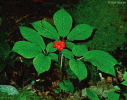 |
The
Most Suitable
Location to Grow Ginseng in Southern British Columbia |
 |
 |
The
Most Suitable
Location to Grow Ginseng in Southern British Columbia |
 |
| Home |
Conceptual
Outline |
Data
Collection |
Methodology |
Spatial
Analysis |
Conclusion |
Problems |
|
Methodology |
| As I researched websites
and journal articles to decided what criteria would be suitable for
deciding the best place to grow ginseng, I came across two distinct
view points. The Commercial
view point and the Traditional
view point. Both had similarities and differences in the criteria
for locating the most suitable location for growing ginseng in southern
British Columbia. The criteria that I used was: 1. Landcover Type
2. Minimum Temperature 3. Maximum Precipitation 4. Slope Each criteria was used as a factor in my analysis, so fuzzy images can be created with comparable suitability values. Each view point was analyzed separately through weighted linear combination. |
| Traditional Point-of-view The traditional point-of-view is based on how ginseng has been grow for hundreds of years. It is more natural way to grow it because it uses the landscape to achieve the required growing conditions. It was stated that the ginseng root has stronger medicinal qualities when it is grown more naturally. The four criteria were manipulated to consider the traditional growers views: Landcover Type There are 11 different landcover types, each representing either a more suitable or less suitable area to grow ginseng. Each type was given a value from 0 (least suitable) to 255 (most suitable). Mixed forest 200 Deciduous forest 255 Water 0 Transitional forest 150 Coniferous forest 200 Tundra 0 Barren 25 Permanent Ice 0 Cropland 50 Rangeland 100 Built-up areas 0 Water, Tundra, and Built-up areas are assigned a value of zero as they can not support a crop. In a commercial operation shade can be created with polypropylene covering or wooden canopies, but in a traditional method, trees are used as the shade. Therefore, barren land is very low suitability, and cropland, which has few trees, is also given a low suitability. Rangeland is given a medium suitability as it may contain more trees than the cropland, but not as many as forests. The forest types range in suitability depending on the types of trees. First is a transitional forest because it may not be as developed. Slightly increasing in suitability is mixed forest and coniferous forest. The most suitable forest type is the deciduous forest and therefore gets a suitability value of 255. Minimum Temperature As ginseng can be easily damaged by cold temperatures a minimum temperature is cutoff at -4 C. More suitability is given to warmer temperatures and less suitability is given to lower temperatures. Maximum Precipitation Ginseng can be damaged by too much precipitation because the soil becomes to moist and diseases and molds start to grow. This requires a suitable area to have a minimal amount of precipitation. A higher suitability is given to areas with little monthly precipitation (starting at around 34 mm) and lower suitability given to areas with higher amounts of precipitation (up to 578 mm). Slope Slope again has two roles in deciding where to grow ginseng. A sloping hill provides better drainage as water does not puddle on the area. Secondly, a slope that is too big will have continuous loss of soil. Therefore, a slope between 1 to 15 degrees is the most suitable, with more suitability given to lesser slopes. Top |
|||
|
|
|
||
| Previous |
Next |
||